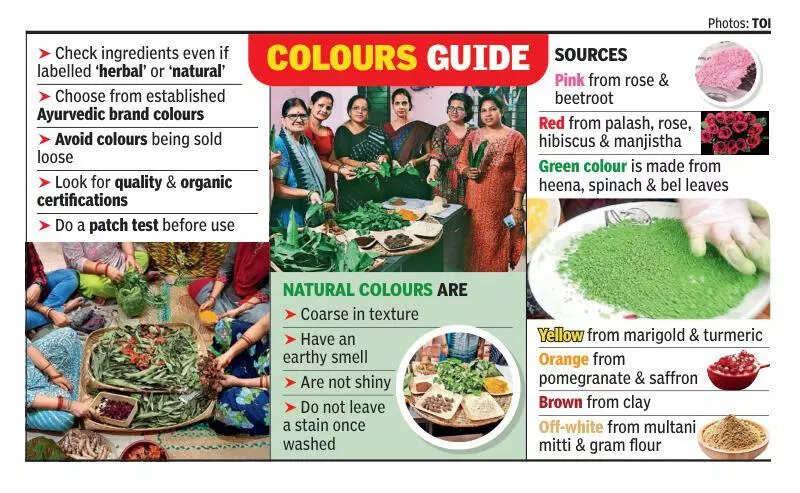Experts caution against shops selling ‘fake’ colours | Bhubaneswar News

Bhubaneswar: With many opting for a safe Holi celebration and one that does not add to environmental pollution, shops these days are selling colours that are labelled ‘organic’, ‘herbal’, ‘natural’ and ‘hand-made’, but experts have cautioned against being hoodwinked as many are selling synthetic ones labelled as ‘natural’.
“Natural or herbal colours are a little coarse in texture and non-shiny in appearance. If there are any shiny particles, then they are not naturally produced. To be doubly sure about the quality of colours available in the market, one can smear a small amount on one’s skin. If it sticks to the skin and leaves a stain, then it has synthetic or chemical ingredients in it. Natural colours have a short shelf life, so check the expiry date or use-by date on the packets. Natural colours have an earthy scent of turmeric and floral fragrances,” Dr Harapriya Das, an Ayurvedic doctor, said.
Dr Das added, “Natural gulals or dry colours are made with turmeric, henna, flowers such as marigold, chrysanthemum, rose, palash, manjistha, Aparajita flower and vegetable extracts like beetroot and spinach and ingredients like gram flour and rice flour.”
A reality check on the products available in the market revealed that very few of the herbal colour packets mentioned the ingredients. Some packets have certifications from various agencies like CSIR-National Botanical Research Institute (NBRI) and the Food Safety and Standards Authority of India (FSSAI). Some packets are also certified by the National Accreditation Board for Testing and Calibration Laboratories or the International Organisation for Standardization (ISO), while others only mentioned ‘lab tested’.
Lipsa Behura who works with a company that produces sustainable products, said, “There is an increased demand for organic or herbal colours. We prepared around 200 kg of colours from natural ingredients and we totally sold out. Preparing natural colours is quite cumbersome, starting from collecting the ingredients and making powder from them, so they are a little costlier than the synthetic colours available in the market.”
Dr Jayant Dash, a plastic and cosmetic surgeon, said, “Check the labels, verify the ingredients and opt for colours.”
Neelima Mishra, director of Ceiba Green Solutions, joined the Odisha Livelihood Mission’s training programme on making natural colours for women self-help groups. “During training, we covered topics such as packaging, pricing differences between natural and chemical Holi colours and a practical demonstration on how to make natural colours using flowers and natural ingredients like turmeric, beetroot, palak, coriander, Aparajita and others. This will help create awareness among people at the grassroots level as well,” Mishra added.
“Natural or herbal colours are a little coarse in texture and non-shiny in appearance. If there are any shiny particles, then they are not naturally produced. To be doubly sure about the quality of colours available in the market, one can smear a small amount on one’s skin. If it sticks to the skin and leaves a stain, then it has synthetic or chemical ingredients in it. Natural colours have a short shelf life, so check the expiry date or use-by date on the packets. Natural colours have an earthy scent of turmeric and floral fragrances,” Dr Harapriya Das, an Ayurvedic doctor, said.
Dr Das added, “Natural gulals or dry colours are made with turmeric, henna, flowers such as marigold, chrysanthemum, rose, palash, manjistha, Aparajita flower and vegetable extracts like beetroot and spinach and ingredients like gram flour and rice flour.”
A reality check on the products available in the market revealed that very few of the herbal colour packets mentioned the ingredients. Some packets have certifications from various agencies like CSIR-National Botanical Research Institute (NBRI) and the Food Safety and Standards Authority of India (FSSAI). Some packets are also certified by the National Accreditation Board for Testing and Calibration Laboratories or the International Organisation for Standardization (ISO), while others only mentioned ‘lab tested’.
Lipsa Behura who works with a company that produces sustainable products, said, “There is an increased demand for organic or herbal colours. We prepared around 200 kg of colours from natural ingredients and we totally sold out. Preparing natural colours is quite cumbersome, starting from collecting the ingredients and making powder from them, so they are a little costlier than the synthetic colours available in the market.”
Dr Jayant Dash, a plastic and cosmetic surgeon, said, “Check the labels, verify the ingredients and opt for colours.”
Neelima Mishra, director of Ceiba Green Solutions, joined the Odisha Livelihood Mission’s training programme on making natural colours for women self-help groups. “During training, we covered topics such as packaging, pricing differences between natural and chemical Holi colours and a practical demonstration on how to make natural colours using flowers and natural ingredients like turmeric, beetroot, palak, coriander, Aparajita and others. This will help create awareness among people at the grassroots level as well,” Mishra added.
















